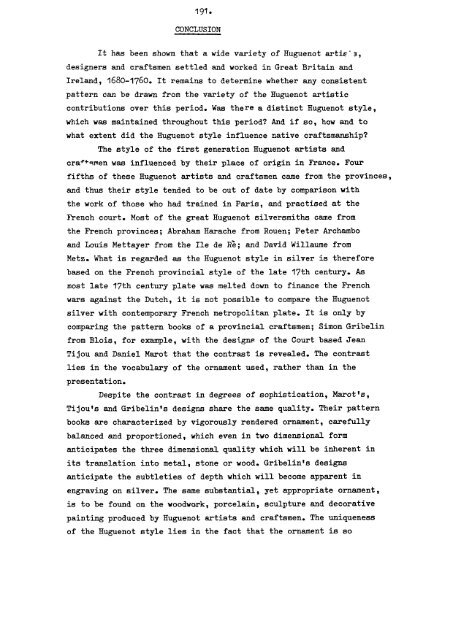HUGIJENOT ARTISTS DESIGNERS AND CRAYPSNEN IN GREAT ...
HUGIJENOT ARTISTS DESIGNERS AND CRAYPSNEN IN GREAT ...
HUGIJENOT ARTISTS DESIGNERS AND CRAYPSNEN IN GREAT ...
You also want an ePaper? Increase the reach of your titles
YUMPU automatically turns print PDFs into web optimized ePapers that Google loves.
191.<br />
CONCLUSION<br />
It has been shown that a wide variety of }Iugtzenot artiE r 3<br />
designers and craftsmen settled and worked in Great Britain and<br />
Ireland, 1680-1760. It remains to determine whether any consistent<br />
pattern can be drawn from the variety of the Huguenot artistic<br />
contributions over this period. Was there a distinct Huguenot style,<br />
which was maintained throughout this period? And if so, how and to<br />
what extent did the Huguenot style influence native craftsmanship?<br />
The style of the first generation Huguenot artists and<br />
cra qmen was influenced by their place of origin in France. Four<br />
fifths of these Huguenot artists and craftsmen came from the provinces,<br />
and thus their style tended to be out of date by comparison with<br />
the work of those who had trained in Paris, and practised at the<br />
French court. Most of the great Huguenot silversmiths came from<br />
the French provinces; Abraham Harache from Rouen; Peter Archambo<br />
and Louis Mettayer from the lie de R; and David Willaume from<br />
Metz. What is regarded as the Huguenot style in silver is therefore<br />
based on the French provincial style of the late 17th century. As<br />
most late 17th century plate was melted down to finance the French<br />
wars against the Dutch, it is not possible to compare the Huguenot<br />
silver with contemporary French metropolitan plate. It is only by<br />
comparing the pattern books of a provincial craftsmen; Simon Gribelin<br />
from Blois, for example, with the designs of the Court based Jean<br />
Tijou and Daniel Marot that the contrast is revealed. The contrast<br />
lies in the vocabulary of the ornament used, rather than in the<br />
presentation.<br />
Despite the contrast in degrees of sophistication, Narot's,<br />
Tijou's and Gribelin's designs share the same quality. Their pattern<br />
books are characterized by vigorously rendered ornament, carefully<br />
balanced and proportioned, which even in two dimensional form<br />
anticipates the three dimensional quality which will be inherent in<br />
its translation into metal, stone or wood. Gribelin's designs<br />
anticipate the subtleties of depth which will become apparent in<br />
engraving on silver. The same substantial, yet appropriate ornament,<br />
is to be found on the woodwork, porcelain, sculpture and decorative<br />
painting produced by Huguenot artists and craftsmen. The uniqueness<br />
of the Huguenot style lies in the fact that the ornament is so
















